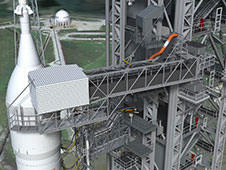Image above:A computer-aided design image of the crew access arm that is being developed for the Mobile Launcher tower. Photo Credit: NASA/Boeing
› View Larger Image

Image above:The mobile launcher made the 4.2-mile trek along the crawler way, Nov. 11, 2011, from Launch Pad 39B to the park site near the Vehicle Assembly Building at NASA’s Kennedy Space Center, after a two-week stay on the pad for structural and functional engineering tests. Photo Credit: NASA file/2011
› View Larger image
NASA Kennedy Space Center’s Ground Systems Development and Operations Program engineers in Florida are combining heritage technology and new innovations to design the crew access arm for the tower on the mobile launcher that will be used for NASA’s Orion spacecraft atop the Space Launch System (SLS) rocket.
Orion will be the most advanced spacecraft ever designed and carry astronauts farther into space than ever before. SLS is designed to be flexible for launching spacecraft for crew and cargo missions and will enable new missions of exploration and expand human presence across the solar system. It will first launch Orion in 2017.
According to Kelli Maloney, a mechanical design engineer in the center’s Engineering Directorate, the mobile launcher’s new 60-foot-long hydraulic arm will be similar in length and speed to the arm used during the Apollo missions. It will have two levels and incorporate hardware from NASA’s Apollo and Space Shuttle Programs.
Located at about the 270 feet high on the 355-foot-tall tower, the upper level will include a new “White Room” that provides access to the Orion crew module. The White Room will contain a six-foot-long access platform, also nicknamed the “diving board,” that will extend through Orion’s outer door to the crew module door. Refurbished Apollo era control console and accumulators also will be part of the new arm.
The lower-level walkway will provide access to two panels on the spacecraft’s service module.
Maloney said design elements from the inflatable dock seal on the shuttle’s orbiter access arm will be reused, as well as storage cabinets and safety equipment from the shuttle-era White Room.
The access arm will rotate out to the crew module on giant Apollo-era hinges. The hinges will be refurbished and retrofitted with new digital encoders to accurately obtain the arm’s position.
“This information will be fed back to the Program Logic Controllers in an electrical room on the Mobile Launcher tower in order to achieve precise control of arm position,” Maloney said.
Platforms from Launch Pad 39B’s fixed service structure will be installed on the mobile launcher tower and provide access to the hinges for inspection and repair.
Maloney said new 3-D design visualization tools are being used to view the concept throughout the design process.
“It’s a challenge, because you have to think about every detail,” Maloney said. “It’s very diverse.”
During the process, heritage parts planned for reuse, such as Apollo-era control consoles, are scanned and then uploaded into a special 3-D design software program. Maloney said this process saves time and costs to modeling existing components.
“Having access to 3-D scanning capabilities is very helpful so that we can see how the design will fit into the existing structures, such as the mobile launcher, the Vehicle Assembly Building and Launch Pad 39B,” Maloney said.
Another innovation for the future is that the White Room can be removed and replaced on the upper level of the arm to accommodate access to larger, planned SLS cargo vehicles and future launch vehicles.
The design team, comprising NASA and Engineering Services Contract engineers, is working toward a 60 percent design review in January 2013. Design work on the crew access arm, as well as other access arms and umbilicals, will continue through 2013. Fabrication of the access arm could begin in 2014, with testing in the Launch Equipment Test Facility at Kennedy in 2015.

























